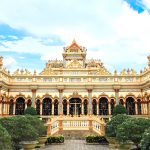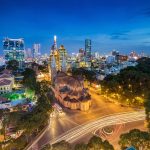Bronze, one of the earliest types of metal, is an alloy of copper mixed usually with a smaller quantity of tin. About 3,000 BC it was used to make weapons and armor while eastern nations started casting statues in bronze.
In Vietnam the trade dates back to the Hung Kings period 2579-258 BC (the first rulers of Van Lang, an ancient united Vietnamese state). The knowledge then spread to China via the ethnic minority groups living on the China-Vietnam border.

Artisans from Kinh Bac (now Bac Ninh) had specialized in bronze casting since the early 11th century. They were one of the first communities to bring the trade to Thang Long (an old name for Hanoi meaning Rising Dragon). They set up in a series of villages, now the Lo Duc Street area south of Hoan Kiem Lake. A pagoda nearby, dedicated to Nguyen Minh Khong regarded as the guardian of the trade, marks the site of the original foundry.
At the end of the 16th century (Later Le Dynasty Warlord period) needing a better location and more water, the artisans petitioned the then king for permission to move to a more suitable area. Neighboring bronze casting families joined them. The trade flourished, supported by the ruling family who were great patrons of arts and crafts.
Centuries ago the Red River changed course leaving a small island on the eastern side of what is now Truc Bach Lake. This is Ngu Xa – formerly a pleasure island for Vietnamese emperors and the bronze casters’ new home. In Sino-Vietnamese ‘Ngu’ means the number five and ‘Xa’ means village. This literally implies five villages. However, it actually refers to one village composed of families from the five communes of Dong Mai, Chau My, Long Thuong, Dao Vien and Dien Tien (now Hung Yen and Bac Ninh provinces).
Bronze casting was one of the four most prestigious crafts of ancient Thang Long. According to an old Hanoi saying: “glossy silk from Yen Thai, pottery from Bat Trang, goldsmiths from Dinh Cong and bronze-casting from Ngu Xa”.
The artisans established their Ngu Xa bronze-casting guild, producing coins for the citadel used as the national currency, furniture for royal palaces and bronze items for places of worship. Their guild was kept separate from the trades of the 36 streets/old quarter. Ngu Xa was chosen for its proximity to water, essential for extinguishing the extremely hot fires, and for high quality special soil good for making the moulds.
Residing on Ngu Xa with 400-year+ histories are Mr Nguyen Van Ung and Mr Hung and their families – descendants of the island’s original bronze casters. Mr Ung’s house is very prominent. A majestic red house overlooking Truc Bach Lake serves as the family home, a small exhibition on the island’s bronze casting history and a museum/showroom of bronze items. Mr Hung, meanwhile, is the very last artisan to have cast bronze on the island. About seven years ago he was commissioned to cast a bell. His client specified it must be cast in his kitchen, which had been his foundry.
Great works of the Ngu Xa bronze casters are prominent in the area. One spectacular example on the island in Than Quang Pagoda is the gigantic hollow black bronze statue of the Amitabha (Infinite Light) Buddha. Created between 1949-1952, the Buddha sits cross-legged on a 1.6 ton 96 petal lotus stand. At 3.95m high, 15m in circumference, weighing 10 tons the statue is the largest single block bronze statue in Vietnam. Meanwhile next door the Ngu Xa communal house is dedicated to Nguyen Minh Khong/Ly Quoc Su is the trade’s founding father, still honored today.
Now bronze casting has long gone from the island due to health & safety reasons, lack of space and pollution. But the trade still flourishes at new casting workshops about 1 km away. Since early 2000 the island is famed for something completely different. Bronze workshops have gone but a plethora of Pho Cuon restaurants abound.
Pho Cuon is the island’s delicious specialty. A type of fresh spring roll, it is made from soft cooked rice paper sheets, similar thickness as Pho noodle, wrapped around herbs, fried beef and pepper. Piled in stacks of 10 cold rolls on a plate it is enjoyed by dipping it in a fish sauce with garlic, carrots, green papaya, rice vinegar, garlic and chili.
Its origins are shrouded in mystery although the island’s Mrs Chinh on Mac Dinh Street takes the credit for its invention. One evening about 14 years ago she had to improvise for a group of hungry customers after her Pho noodle soup broth had run out. The fresh roll creations she conjured up were heartily devoured and for lovers of Pho Cuon the rest is history.
Extra information
Ngu Xa Island linked to Tran Vu and Truc Bach streets by 2 small paths south of Yen Phu street
Ngu Xa communal house open (07:30-11:30 and 14:30-18:30)
Than Quang pagoda, 44 Ngu Xa (open 07:30-11:30 and 14:30-18:30)
Source: ehgnews.com






